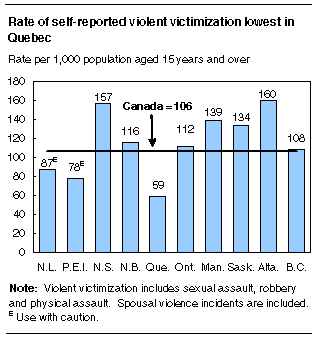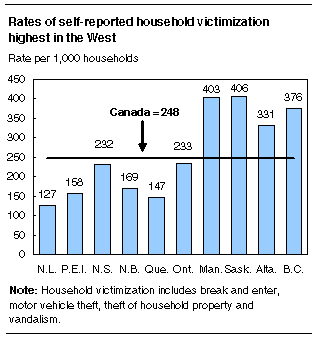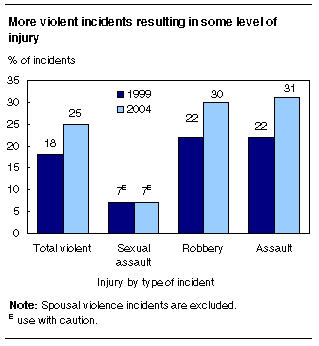
















 |
|
 |                |
Information identified as archived is provided for reference, research or recordkeeping purposes. It is not subject to the Government of Canada Web Standards and has not been altered or updated since it was archived. Please "contact us" to request a format other than those available.

|

Thursday, November 24, 2005 General Social Survey: Criminal victimization2004The rate of violent victimization in Canada, based on information provided by Canadians themselves, was no higher in 2004 than it was five years earlier, according to a new survey that examined the extent and nature of criminal victimization. Data from the General Social Survey (GSS) in 2004 found no significant change in self-reported rates of violent victimization, namely sexual assault, robbery or physical assault. However, rates rose by 24% for theft of personal property, 42% for theft of household property and 17% for vandalism. The only type of offence to show a significant decline was breaking and entering, where rates fell by about one-fifth. The survey asked roughly 24,000 people in 2004 about their experiences with criminal victimization. Anyone who reported they had been the victim of one of eight offences in the previous 12 months was asked for detailed information. This included where the incident occurred; whether the incident was reported to the police; and the level of injury, use or presence of a weapon, and financial loss. The risk of self-reported violent victimization was highest among young people aged 15 to 24, single people, those who frequently participated in evening activities and those who lived in an urban area. In general, people living west of the Manitoba-Ontario border were also at higher overall risk of victimization, but there were some exceptions.
Among the 1% of the population that identified themselves as gay or lesbian, the self-reported rate of violent victimization was about 2.5 times higher than the rate for heterosexuals. In about 4% of all self-reported victimization incidents, victims believed it was hate-motivated, unchanged from 1999. Violent offences were more likely than others to be hate-motivated. GSS data showed that in 2004, 8% of violent offences were believed to be motivated by hate, compared with 2% of household offences. The most common motive was the individual's race or ethnicity, which represented two-thirds of hate-motivated incidents. About one-quarter of those incidents were believed to be motivated by the victim's sex, followed by religion and sexual orientation. These results were similar to those in 1999. Violent crime rates highest in Alberta and Nova ScotiaResidents of the western provinces generally reported higher rates of victimization, with one exception. Nova Scotia's rate of 157 incidents per 1,000 population ranked among the highest for violent victimization and was similar to the rate of 160 recorded for Alberta. Halifax appeared to contribute to Nova Scotia's high rate of violent victimization. It was the census metropolitan area with the highest rate of violent incidents for every 1,000 population. Quebec residents experienced the lowest rates of violent victimization. Its rate was generally half that of the western provinces and Nova Scotia. 
Rates of household crime higher in Western CanadaWith respect to household victimization, which includes breaking and entering, motor vehicle thefts, household property thefts and vandalism, the highest rates were all in the West, in particular Saskatchewan and Manitoba. These two provinces also led the way with the largest increases in household related offences since 1999. 
Newfoundland and Labrador had the lowest rate of household victimization followed by Quebec. In terms of personal property theft, Ontario had a rate of 103 per 1,000 population. This was higher than provinces to the east, but similar to those reported by western provinces. Residents of Quebec and Newfoundland and Labrador were least likely to report have been a victim of personal property theft. Violent crime stable, but more victims getting hurtDespite the relative stability in self-reported rates of violent victimization between 1999 and 2004, a greater proportion of incidents resulted in injury to victims in 2004. One-quarter of violent victimizations in 2004 led to injuries, up from 18% in 1999. However, this increase was likely the result of less severe types of injuries, such as minor cuts and bruises, given the proportion of victims seeking medical attention did not change. 
For some victims, the incident had an impact on their life, as many had difficulty carrying out everyday activities, such as going to work or school. This was the case in more than one-third of self-reported robberies, compared with about one-quarter of self-reported sexual assaults and slightly more than one-fifth of self-reported physical assaults. Youth, single people more at risk of victimizationViolent victimization was highest among young people aged 15 to 24, and the risk steadily declined as age increased. Rates in this age group were 1.5 times higher than those for people aged 25 to 34, and 19 times higher than for seniors aged 65 and older. Single people, who tend to be younger on average, were 1.5 times more likely to be violently victimized as people in common-law unions, and almost four times as likely as married people. People who frequently participated in evening activities had a rate of 174 incidents per 1,000 population. This was four times the rate for people who participated in few evening activities. While overall rates of violent victimization did not differ between men and women, men were at greater risk of physical assault. Women were at higher risk of sexual assault. Rates of victimization were also higher among various sub-groups. For example, individuals who identified themselves as Aboriginal were three times as likely as the non-Aboriginal population to report being a victim of a violent offence. This remained true even when controlling for other factors such as age, sex, and income. In terms of household property offences, the risk was highest among short-term residents, renters and households with high incomes. For household victimization, rates were highest among those who lived in their residence less than one year. Rates fell as the term of residence increased. Rates of household victimization also increased with household income. When household income hit $60,000 or more, the self-reported victimization rate was 300 incidents per 1,000 households. This was 88% higher than the rate for households with income of less than $15,000. Victims reporting fewer incidents to policeThe survey also revealed that fewer victims of criminal offences are reporting the incidents to police. In 1999, 37% of all incidents were reported to police. By 2004, this had slipped to 34%. This was the result of a decline in reporting of property-related offences, such as breaking and entering, theft of motor vehicles or parts, and personal property thefts. Reporting to police has remained fairly stable for violent victimization, thefts of household property and vandalism. As in previous years, the victimization least likely to be reported was sexual assault. Only 8% of sexual assaults were reported to police, compared with 54% of break-ins, 49% of thefts of motor vehicle/parts, 39% of physical assaults and 46% of robberies. On the other hand, sexual assault victims were almost twice as likely as victims of physical assault to seek help from social services and support centres, such as counsellors, crisis centres and help lines. Generally, reporting to police depended on the severity of the incident. Indeed, a main reason given by victims for not reporting an incident was that it was not considered important enough. Certain factors (injury, the presence or use of a weapon, and the need to take time off from activities such as work) increased the likelihood that a violent incident would be reported. For household victimization and personal property thefts, rates of reporting were highest when there was significant financial loss. Definitions, data sources and methods: survey number 4504. The Juristat: Criminal Victimization in Canada, 2004, Vol. 25, no. 7 (85-002-XIE, $9/$75; 85-002-XPE, $11/$100) is now available. For more information, or to enquire about concepts, methods or data quality of this release, contact Information and Client Services (1-800-387-2231; 613-951-9023), Canadian Centre for Justice Statistics. The public-use microdata file for the General Social Survey on Victimization, 2004, cycle 18 is now available on CD-ROM (12M0018XCB, $2,140), and is supported by the User's Guide for the General Social Survey cycle 18: Victimization, 2004 (12M0018GPE, $75). To order these products, contact Client Services and Dissemination, Social and Aboriginal Statistics Division (613-951-5979; sasd-dssea@statcan.gc.ca).
| |||||||||||||||||||||||||||||||||||||||||||||||||||||||||||||||||||||||||||||||||||||||||||||||||||||||||||||||||||||||||||||||||||
|
|
|